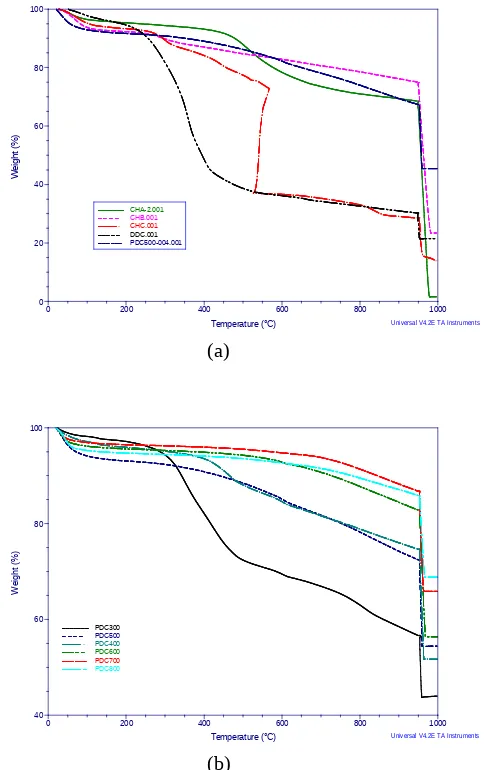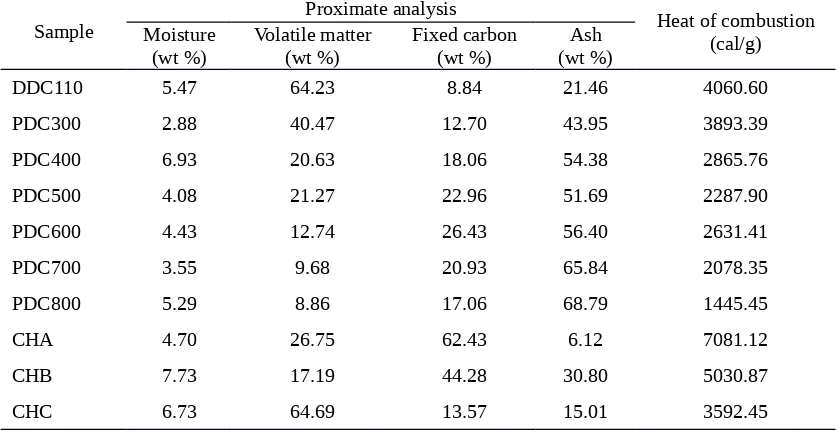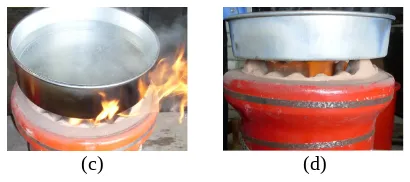Solid Fuel from Decanter Cake: A Preliminary Study
Mohd Haizal Mohd Husin, Nugroho Dewayanto, and Mohd Ridzuan Nordin
Abstract -
Decanter cakes are the major wastes
in crude palm oil industry which are currently
disposed in the landfill or reuse as fertilizer.
But on other side, decanter cakes has
potentially as a solid fuel same as a charcoal
or wood briquette, based on their calorific
value cause of the residual oil in decanter
cakes. This paper presents the initial findings
of a thermogravimetric analysis (TGA) and
heat of combustions by using oxygen bomb
calorimeter methods for characterizing the
different pyrolyzed decanter cakes (PDC).
Meanwhile, the actual heat transferred value
technique for comparing potential decanter
cake with commercial solid fuel types,
charcoal, coconut charcoal and charcoal
briquette. Observation about flame, duration
time of burning process and ash contents also
will take out for comparison.
Key words: Solid fuel, Decanter cake, Thermogravimetric analysis, Heat of combustion and Actual heat transferred value
I. INTRODUCTION
The crude palm oil industry become a very important agriculture based industry and major contributed to economic development in Malaysia. In 2005, Malaysia’s crude palm oil industry produced 15 million tones per years with annual growth of 11.93% per year since 1960 [1], In the same time, crude palm oil production generates large amounts of process residues such as fibers, shell, and empty fruit brunches. These residues are already reuse or recycled as a more valuable product such as activated carbon, fertilizer or solid fuel.
Besides, in crude palm oil dry process mill, decanter was used as separator to remove fine solid and water after homogenous oil mesh from digester was
pushed through a screw press [2]. At this stage, decanter cakes are the major wastes, which are currently disposed in the landfill or reuse as a fertilizer and animal nutrition sources due to the presence of C, N, P, K and Mg [3]. In theories of residual oil in decanter cake it might to be a potential solid fuel based on their calorific values, same as the coal, charcoal, wood or briquette and even palm oil solid waste likes fibre, shell and kernel or their blends in biomass [2,4] and used as a fuels for the boiler instead of fossil fuel [5].
According to Nasrin et al. [6], from the experiment carried out, converting palm biomass likes empty fruit bunch, fibre and kernel into a uniform and solid fuel through briquetting process using screw extrusion technology were satisfactory compared to commercial sawdust briquettes. Meanwhile, reviewed by Sumiani [7] the press fibre and shell generated by the palm oil mills are traditionally used as solid fuels for steam boilers. These two solid fuels alone are able to generate more than enough energy to meet the energy demands of a palm oil mill.
At this moment, solid fuel industry was started with wood wastes, most of the local solid fuel likes sawdust briquettes or charcoal briquettes are exported for oversea markets. The products are rarely used in the local market as it could not compete with the availability of cheap fuels such as wood, charcoal and kerosene which are widely used in the rural areas and restaurants. This industry has grown impressively for the past few years and indicated that there is good return for investment [8].
The aim of this work is to study the potential of decanter cake which is waste from palm oil mill as a solid fuel based on proximate analysis, calorific value and actual heat transferred value.
II. EXPERIMENTAL
Materials
The decanter cakes from palm oil mill waste or effluent were supplied by LKPP Corporation Sdn. Bhd., Lepar Hilir, Kuantan, Pahang. The decanter cakes were shaped into the sphere pieces within 5 cm diameter (approximately 60 ± 5 g by mass) and dried into the oven for 8 hour at the temperature 110°C and labeled as a DDC before pyrolysed into furnace under ambient atmosphere at the temperatures of 300 to 800°C for 2 hours and labeled as a PDC300, PDC400, PDC500, PDC600, PDC700 and PDC800 respective on
M.H, Mohd Haizal is with Faculty of Chemical and Natural Resources Engineering, Universiti Malaysia Pahang, Kuantan 26300 Malaysia and also Faculty of Mechanical, UTeM
N. Dewayanto is with Faculty of Chemical and Natural Resources Engineering, Universiti Malaysia Pahang, Kuantan 26300 Malaysia
temperature of pyrolysis. For comparisons, commercial solid fuel used in these projects likes wood charcoal, charcoal briquette (E-Ignition) and charcoal briquette (coconut shell) from domestic supplied and labeled as a CHA, CHB, and CHC respectively.
Proximate Analysis and heat of combustion
The materials prepared were analyzed for thermogravimetric analysis using a TA Instruments-Waters’ TGA Q 500 Instrument to determine thermal properties and proximate analysis. The samples were heated in nitrogen atmosphere from ambient temperature to 950 oCat a heating ramp of 20oC/min.
The gas was switched into oxygen and heated to 1000oC at heating ramp of 5oC/min. The sample mass
used in all runs was equal to 160 mg. Meanwhile, the heat of combustion of the materials was determined with a Parr 1341 Oxygen Bomb Calorimeter. 1 gram of sample was introduced to the combustion chamber. Amount of oxygen was flowed in to the chamber, and ignited by an electronic ignition unit. Heat of combustion was calculated from the raising of water temperature in the calorimeter bucket.
Actual heat transferred value
The actual heat transferred value of materials were studied using a typical open air stove as an attempt to simulate the actual combustion situation for domestic heating or cooking and the firestarter medium was used to instant these process. The 600.0 g materials were used in combustion process within 2.0 L of water for heating up for looking on actual heat transferred value calculated from the amount of water vaporized until the material was completely combusted, according the equation:
Q1 = m1 Cp (Tb-T0) (eq. 1)
Where Q1 is heat required (calorie) to heating up water
from initial temperature, T0 to boiling temperature Tb,
m is mass of water in gram, and Cp is average heat
capacity of water, 1 cal/g.oC.
Q2 = (m1-m2) (eq. 2)
Where Q2 is heat required to vaporize water, m2 is
amount of water after the combustion test completed.
Qt = Q1 + Q2 (eq. 3)
Where Qt is total heat transferred from solid fuel
combustion to water.
Observation about a flame, duration time of combustion process and ash contents also will take out for comparison.
III. RESULT AND DISCUSSION
Plot of thermogravimetry analysis is shown in Fig. 1. The removal of water from the external surface and moisture from the voids of the structure was completed at about 200oC. The volatile matter leaves
the adsorbent between 200oC and 950oC. Fixed carbon
was determined by switching from nitrogen atmosphere into oxygen atmosphere at 950oC. Final weight at
1000oC was identified as ash content of materials.
Proximate analysis of DDC110 indicated it consists of 5.47 % moisture, 64.23 % volatile, 8.84 % fixed carbon and 21.46 % ash.
Table 1 shows the proximate analysis and heat of combustion obtained from oxygen bomb calorimeter analysis. From the table below, the heat of combustion for DDC110 is 4060.60 cal/g, was higher compared to other PDC. But, sample CHA was highest values of heat of combustion among samples which is 7081.12 cal/g, and proximate analysis of CHA indicated it consists of 4.70 % moisture, 26.75 % volatile, 62.43 %
Table 1: Proximate analysis and heat of combustion of samples
Sample
Proximate analysis Heat of combustion (cal/g) Moisture
(wt %) Volatile matter(wt %) Fixed carbon(wt %) (wt %)Ash
DDC110 5.47 64.23 8.84 21.46 4060.60
PDC300 2.88 40.47 12.70 43.95 3893.39
PDC400 6.93 20.63 18.06 54.38 2865.76
PDC500 4.08 21.27 22.96 51.69 2287.90
PDC600 4.43 12.74 26.43 56.40 2631.41
PDC700 3.55 9.68 20.93 65.84 2078.35
PDC800 5.29 8.86 17.06 68.79 1445.45
CHA 4.70 26.75 62.43 6.12 7081.12
CHB 7.73 17.19 44.28 30.80 5030.87
CHC 6.73 64.69 13.57 15.01 3592.45
Fig 2, shows the comparison of heat of combustion and heat transferred among solid fuel. Where the heat transferred values obtain from actual heat transferred value mean and heat of combustion value obtain from bomb calorimeter. Looking to comparison of heat of combustion and actual heat transferred, generally heat transferred value less than heat of combustion, its due to heat loss to surrounding when its combusted. For CHA it is 20% of heat values that heat of combustion and for DDC up to 30%. It is clearly that heat transferred value for DDC110 is 1239.46 cal/g lower compared to 1536.73 cal/g for commercial solid fuel sample CHA. But, DDC110 is much higher in actual heat transferred values compared to other commercial solid fuel samples of CHB and CHC. So that, the decanter cake might to be potential solid fuel where 80% of heat transferred compared to commercial wood charcoal.
During open combustion of solid fuel, most of samples were not easy to ignite, therefore, firestarter medium was used to instant the process. Fig 3 shows the photographs of combustion process; it can be observe that DDC sample more flaming compare to wood charcoal, CHA .when its combusted.
DDC CHA CHB CHC
0 1000 2000 3000 4000 5000 6000 7000 8000
4060.6
7081.12
5030.87
3592.45
1239.46 1536.73
947.59 1028.03
heat of combustion heat transferred
Solid Fuels
H
C
,
H
T
,
ca
l/
g
Fig. 2: Comparison of Heat of Combustion and Heat Transferred for Solid Fuels.
(c) (d)
Fig 3: Photograph of (a) sample of DDC110, (b) initial combustion of DDC110, (c) flame of DDC110, and (d) flame of CHA.
IV. CONCLUSION
This paper presents preliminary study of decanter cakes from palm oil mill waste should be considered as a solid fuel. From calorific value, sample dried decanter cake have great potential to be a solid fuel. While the actual heat transferred value of decanter cake shows that 80% of heat transferred value compared to commercial wood charcoal. Just dried without pyrolysed, the decanter cake can be transform into the solid fuel might to be lower costing of preparation. Observation on flame, DDC more flaming compared to other solid fuel.
ACKNOWLEDGEMENT
The authors gratefully acknowledge Universiti Malaysia Pahang for supporting the research through RDU080302.
REFERENCES
[1] Yusof Basiron (2007). “Palm oil production through sustainable plantations”. Eur. J. Lipid Sci. Technol. 109. 289–295.
[2] S. Prasertsan and P. Prasertsan. (1996) “Biomass Residues From Palm Oil Mills In Thailand: An Overview On Quantity And Potential Usage” Biomass and Bioenergy Vol. 11, No. 5, pp. 387-395.
[3] Chavalparit, O., Rulkens, W. H., Mol, A. P. J., Khaodhair, S., (2006),“Options for environmental sustainability of the crude palm oil industry in Thailand through enhancement of industrial ecosystems”, Environmental, Development and Sustainability, Vol. 8, , pp. 271-287
[4] P. Luangkiattikhun, C. Tangsathitkulchai, and M. Tangsathitkulchai. (2008) “Non-isothermal thermogravimetric analysis of oil-palm solid wastes”. Bioresource Technology. 99. 986–997 [5] T.M.I. Mahlia, M.Z. Abdulmuin, TMI Alamsyah, D. Mukhlishien. (2001). “An Alternative energy source from palm wastes industry for Malaysia and Indonesia”. Energy Conversion and Management. 42. 2109-2118. [6] A.B.Nasrin, A.N.Ma, Y.M.Choo, S.Mohamad,
M.H.Rohaya , A.Azali and Z.Zainal (2008). “Oil Palm Biomass As Potential Substitution Raw Materials For Commercial Biomass Briquettes Production”. American Journal of Applied Sciences 5 (3): 179-183,
[7] Sumiani Yusoff. (2006). “Renewable energy from palm oil - innovation on effective utilization of waste”. Journal of Cleaner Production 14. 87-93.
[8] Hoi Why Kong, 1995. Wood and Charcoal Briquetting in Malaysia. In: Proceedings of International Workshop on Biomass Briquetting, 68-74.


